Tack
The tack is a functional move where the nose of the board passes through the eye of the wind. This allows the rider to make a directional change without moving downwind which is especially important in waves because you are often fighting to stay upwind. The move requires timing and quickness with only a small window of time for completion. In addition, the tack is a move for safe and responsible sailing because when all the jibe-only sailors are downwind, you can avoid possible collision by tacking upwind and away from the congestion. In my opinion, responsible sailors commit to learning the short-board tack shortly after learning to jibe. The more options the better.
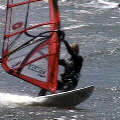
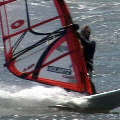
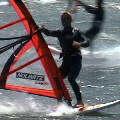
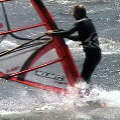
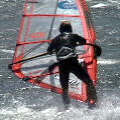
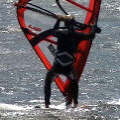

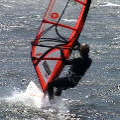
Rider: Royn Bartholdi
Steps
 1)
With speed, unhook, get out of the straps, and rake the sail back toward the tail (oversheeting) so the board heads into the eye of the wind. Remember, safety first -- in all moves all the time! So verify your have room and will not collide with another sailor (pay close attention to an upwind sailor coming downwind in a ballistic jibe.). You will head upwind farther than you think and you will be blind to upwind traffic in the middle of this maneuver.
1)
With speed, unhook, get out of the straps, and rake the sail back toward the tail (oversheeting) so the board heads into the eye of the wind. Remember, safety first -- in all moves all the time! So verify your have room and will not collide with another sailor (pay close attention to an upwind sailor coming downwind in a ballistic jibe.). You will head upwind farther than you think and you will be blind to upwind traffic in the middle of this maneuver.  2)
Move the forward foot to the front of the mast and shift the back foot slightly forward while your keep the sail racked back. Also, keep sheeting in the sail with your back hand to maintain power in the sail and board speed. Most people grab the mast below the boom with the front hand at this point -- I don't. Speed is your friend!
2)
Move the forward foot to the front of the mast and shift the back foot slightly forward while your keep the sail racked back. Also, keep sheeting in the sail with your back hand to maintain power in the sail and board speed. Most people grab the mast below the boom with the front hand at this point -- I don't. Speed is your friend!  3)
As the nose of the board (NoB) approaches the eye of the wind (EoW) then slide your front foot over the centerline and transfer your weight onto the front foot. This should be done while the board is planing. Give one last tug with the back hand and then release it and grab the boom head or the mast right below the boom. Release the front hand during the grab. Quickly!
3)
As the nose of the board (NoB) approaches the eye of the wind (EoW) then slide your front foot over the centerline and transfer your weight onto the front foot. This should be done while the board is planing. Give one last tug with the back hand and then release it and grab the boom head or the mast right below the boom. Release the front hand during the grab. Quickly!  4)
Shift both feet to the front of the board, but as close to the mast as possible with your body balanced over the centerline of the board.
4)
Shift both feet to the front of the board, but as close to the mast as possible with your body balanced over the centerline of the board.  5)
Pull the mast toward the nose of the board while simultaneously grabbing the boom on the other side of the sail and placing your new back foot between the foot straps. This feels like you are just stepping aside and letting the rig pass by you; instead of you stepping around and passing by the rig. This is where most people topple.
5)
Pull the mast toward the nose of the board while simultaneously grabbing the boom on the other side of the sail and placing your new back foot between the foot straps. This feels like you are just stepping aside and letting the rig pass by you; instead of you stepping around and passing by the rig. This is where most people topple.  6)
Sheet in and pull the boom up with the back hand while pushing the front hand forward (this is called the bow and arrow position) to present the other side of the sail to the wind and power up the sail for the new board direction.
6)
Sheet in and pull the boom up with the back hand while pushing the front hand forward (this is called the bow and arrow position) to present the other side of the sail to the wind and power up the sail for the new board direction.  7)
Push on the front foot until the board is sufficiently pointing in the new direction. Trim, adjust feet and sail away you tack meister.
7)
Push on the front foot until the board is sufficiently pointing in the new direction. Trim, adjust feet and sail away you tack meister. Videos
Loading the player ...
This Standard Tack demonstrates leaning the sail back (oversheeting) to initiate the maneuver and to drive the nose into the wind. This is followed by stepping the forward foot in front of the mast base, stepping to the other side of the sail, and pulling the mast forward. Remember to keep your body weight over the centerline of the board.
Tips
- Speed is your friend! Momentum and speed keeps the board stable. The shorter the board the faster the speed drops when heading upwind. So try a bigger board at first.
- If you are stalling out and falling off the front of the board then you need to speed up your movement and get to the other side of the board quicker.
- Most sailors are not aggressive enough and are doomed from the beginning -- so be very aggressive. Sometimes I have beginners just practice one step over and over until they are charging like an angry bull.
- Notice in step #1 my arms are straight to counterbalance the sail and to make room for my body movement.
- The non-planing tack (slog tack) is a very different transition.
- Ultimately the feet work is a shuffle, much like a fencer shuffles their feet, and not a jump. But sometimes, while learning this maneuver a sailor gets locked up, frozen, and can not get to the other side. Then, as a temporary corrective measure, by all means jump man jump.
Ideas
- Try the one or zero handed tack.
- Throw a Pirouette into the move.
- Insert a sail throw into the move.
All Contents Copyright © 2008-2025 Royn Bartholdi. All Rights Reserved